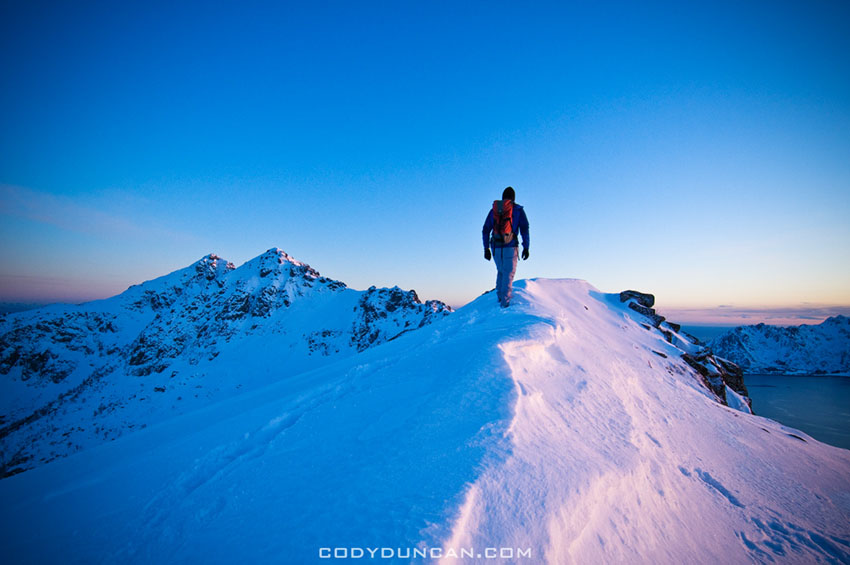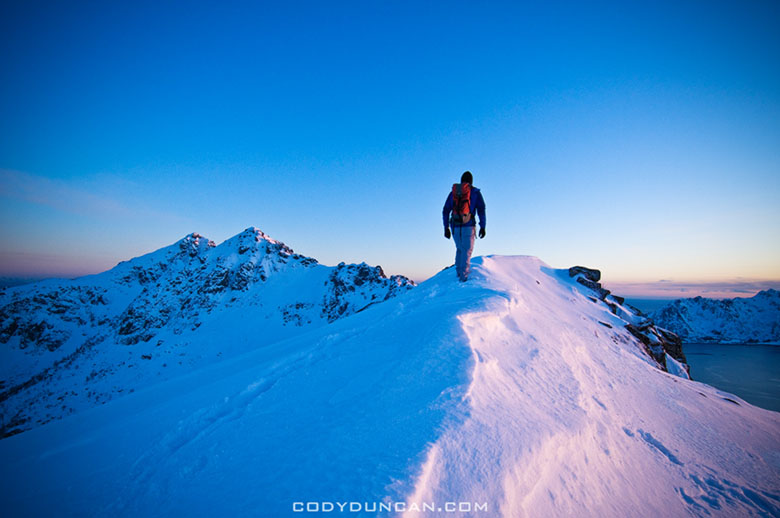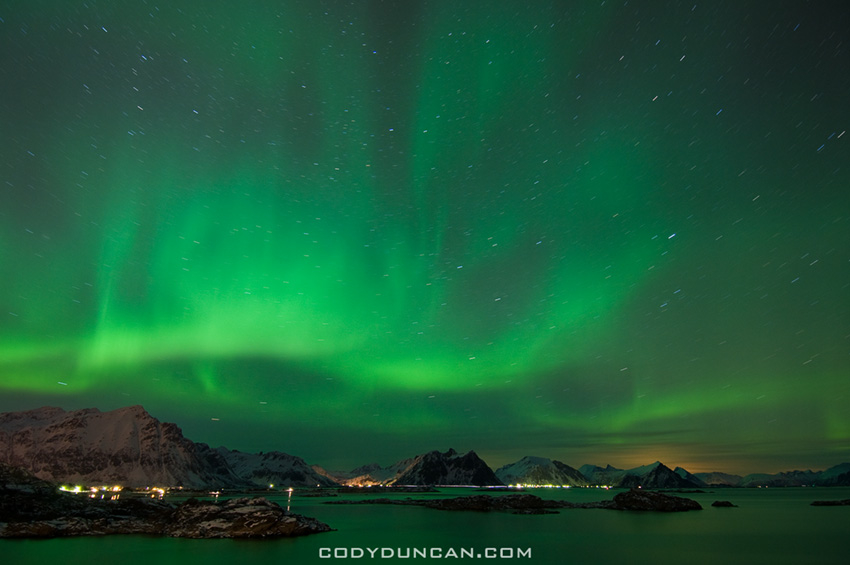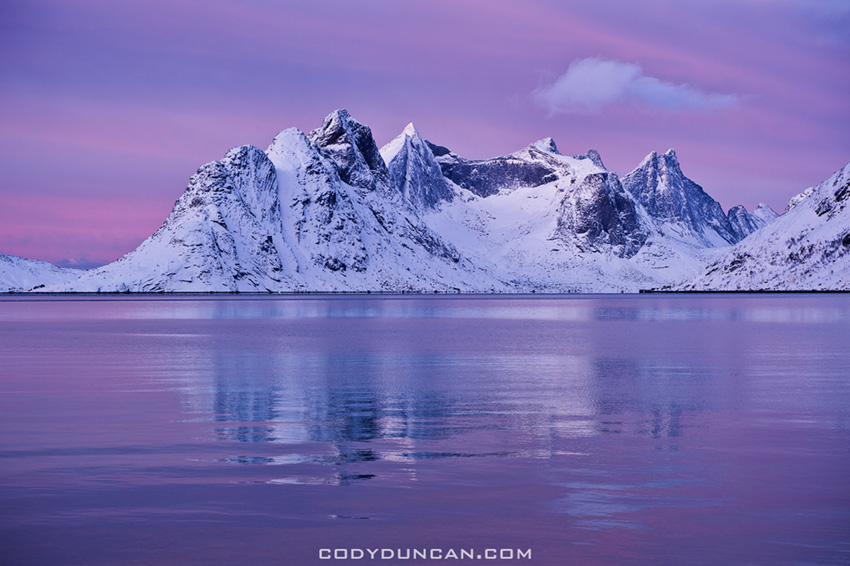



The Lofoten Islands are located roughly 100 miles north of the Arctic Circle off the west coast of Norway, separated from the mainland by the waters of Vestfjord. Even with the efficient Norwegian transportation system, if traveling from outside the country it can take 24 hours in transit before one sets foot on the islands. The city of Bodø on the Norwegian mainland acts as the gateway to Lofoten and many travelers will pass through here. It is fastest to fly, but I can't help but feel that this takes away an essential part of the journey: crossing the sea with building anticipation as the wall of 1,000 meter mountains slowly rises in the distance. I still remember seeing it for the first time all those years ago. This is the way Lofoten must be approached. The wind and sea need to be felt. The gentle rocking of the ferry on a calm summer evening, or the spray of seawater and crashing of waves in the darkness of a winter gale. It is all part of the journey and of the islands.
Change is constant on the Lofoten islands. Each month differs from the prior and the following. December is ruled by darkness. The sun returns again in January. February sees stockfish start to cover the land. The days grow longer in March. April sees the snow begin to melt. Night disappears in May. The sun never sets in June. Summer arrives in July. Summer ends in August. The land turns golden in September. Snow arrives in October. The land freezes in November.

For me the islands are about reading in a hostel, or my tent, waiting for the weather to clear. About shared meals with new friends. Insomnia and going to sleep at 6am in the summer because it really doesn't matter anyhow—it is always light. Camping on empty beaches and watching the sun sink into the sea at 11:30 pm. Running out of water high in the mountains, yet unable to leave because the day is so brilliant. Midnight hikes under a perfectly blue sky. Conversations around a warm fire late into autumn nights while watching the first snow fall outside. Seeing the northern lights appear and running back to the hostel to tell everyone to come out. The smell of stockfish in the crisp winter air. The smiles and excitement of people on the ferry seeing the islands for the first time. Hitchhiking with fishermen, fellow travelers, families, the postman, and hearing the stories of their journeys. Not checking my email for two weeks, nor having a phone. People saying they are leaving tomorrow, yet they are still there a week or two later. Arriving and feeling like I'm home again, the streets familiar in my mind. Days of rain, sun, wind, rain, sun, hale, rain, sun, wind…
If I'm to offer advice on when to visit the islands for the first time, the answer is a simple one: summer. For those of us living at milder latitudes, 24 hours of light is truly unforgettable. It can take a bit of adjustment, but as the days pass you'll cease to care what time you go to sleep or wake up. The sun is always there somewhere in the sky, or more accurately, somewhere behind the clouds. No matter what time of year it is, the sky is more often gray than blue. Yet a single bright, sunny day more than makes up for the previous rain.
Summer on the islands is the time to get out and explore. A nearly endless supply of mountains leaves visitors constantly looking toward the sky. With everything from easy hikes on gently wandering trails to technical climbs, there are options for all. One of the most popular hikes is to the 448 meter high Reinebringen, which reaches the most iconic view of the Lofoten Islands. From the summit you can see over the villages from Reine to Hamnøya and the almost vertical walls of rock rising out of the fjord nearly cutting Moskenesøya in two.
The northern Atlantic coast of the islands is blessed with some of the most scenic beaches I've ever set eyes upon, often with steep granite peaks rising high above. The turquoise blue water is almost tropical in appearance, and remains so as long as you look but don't touch. Many of the beaches such as Bunes, Kvalvika, and Horseid can only be reached on foot and offer idyllic places to camp for a few nights. Driftwood is usually plentiful enough for a summer barbecue, and because it won’t get dark you can eat dinner at 9pm under full sunlight. Other beaches such as Utakleiv, Unstad, Ramberg, Skagsanden, Eggum and the north of Gimsøya can be easily reached by car and are perfect places for watching the midnight sun, though expect a few others to have the same idea. Eggum, in particular, can be chock full of motorhomes and campers throughout the summer, yet a short walk down the trail at the end of the camping area will usually leave any crowd behind.

Although life under the midnight sun is extraordinary in itself, high summer is not the most photogenic time of the year on the islands. The most magical light of the north is found in the dead of winter. In December the sun disappears below the horizon, not returning again until January. It is these first days after the sun's return that bring the most atmospheric conditions. Perhaps the brilliance of a summer day is packed into the short 3-4 hours of light, even though the sun barely rises above the sea on the southern horizon. Or maybe the pink glow of the sun, full of life after a winter's sleep, is there to bring warmth to the snow covered land.
Rain or snow are never far on Lofoten—they are a part of life both frustrating and rewarding. As a photographer, I find the light and textures that exist on the edges of the storms particularly beautiful. Often I find myself chasing storms, hurriedly setting up my camera as I watch the curtains of rain rush towards me. Inevitably the rain comes too soon and often I wish for just a few more moments of clarity. Perhaps it wouldn’t have mattered—no image could record the magnificence of the islands. They are beyond what can be captured in a single moment of time.
Lofoten has called me back again and again over the years. Even as I write this I am planning another journey for the months ahead. And I'm far from alone in my feelings. I've had conversations with people from all walks of life who make the journey north every year or even multiple times per year, some for three decades or more. If you spend enough time on Lofoten you'll soon feel as I do: it is an Arctic paradise, the center of the universe.
Cody Duncan is originally from Santa Barabara, California, with hopes of settling on the Lofoten Islands in Norway. He has traveled there often, during all seasons, and his photographs are among the very best at capturing these incredible landscapes. Cody’s work can be found at www.codyduncan.com and www.68north.com.